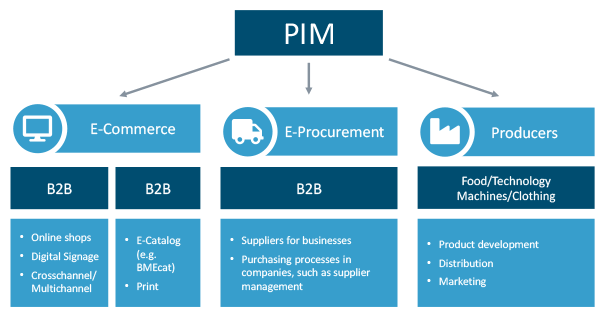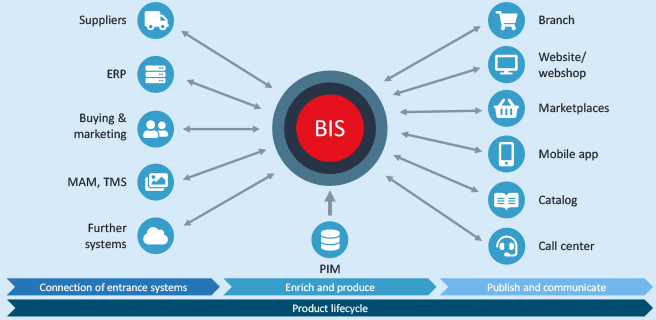Product Information Management (PIM): How to Easily Share Your Product Data

Have you ever wondered how large or globally active companies manage to maintain product details across different shops and channels? If you think of manufacturers, wholesalers or retailers with extensive product ranges, one thing is clear. They can’t do this without help. The simplest solution is a product information system. Read on to discover what a PIM does and how it could help your company.
Imagine the scene. You’ve gone to a supermarket and want to buy some particularly nice coffee. You’re looking for quality and are happy to pay a little extra. But, you also want to know more about the product. Where have the beans come from? Which plantation? Do the growers use fertiliser? Is the coffee Fairtrade? Organic? This type of information can be centrally managed and maintained by a product information management system, keeping it up-to-date for a variety of scenarios.
That was a comparatively simple everyday example. A more complex example from the B2B arena would be a screw manufacturer. They have a range of over 1,000 screws for various uses in different sizes, thread widths, materials and with different heads. Imagine how they and their customers could benefit from a product information management system: article numbers and descriptions, photos, delivery conditions, which they can also share with DIY marketplaces. Indeed, if you think of the sheer range of products on an online shopping platform, imagine the information there must be behind the scenes. This is where a product information management system can help. However, let’s start at the beginning.
What is PIM?
As the name suggests, product information management, or PIM for short, involves using a digital system for managing product information. A PIM system centrally and uniformly manages product information from a variety of different sources. This information includes technical, logistical, marketing-relevant and other details.
The information may be stored as text, images, videos, PDFs, numerical fields, reference lists, URLs, and more. It moves between suppliers and in-house systems (ERP, merchandise management, DAM (digital asset management), shop systems, etc.). Taking a holistic PIM approach, the product data is stored centrally in a database, updated and shared with various marketing and sales channels. This ensures that labels or online shops contain the same, up-to-date information.
How does a PIM system work?
A PIM system encompasses the following product data functions:
- Collection: Product data is collected in an interdisciplinary and cross-company way and compiled in a targeted manner.
- Maintenance: The appropriate departments maintain and update the database, adding new information as necessary.
- Preparation: You can raise the quality of the information collected by merging and processing the data. For example, images and product data can be merged into text for customer information and marketing purposes.
- Distribution: Those with access to the database can now draw the information they need from the system.
What does a PIM system need to do?
In order to collect, maintain, prepare and provide product information, a PIM needs to be able to fulfil certain tasks. When choosing a PIM system, you need to look out for the following.
What tasks does a PIM system do?
These are the most important tasks required to centrally distribute product information[1]:
- Centralise product details
- Collate and enhance the information
- Link up relevant information: text, images, other media
- Make high-quality, reliable product information available to all stakeholders
- Automatically map price information and other details per wholesaler
- Speedily add new products
- Continually maintain and update product details
- Translate information into desired language/s through integrated machine translation tools
- Share relevant product & service data to defined e-commerce platforms
Basically, any B2B or B2C marketing and sales to the end customer will benefit from a PIM system.
What should a PIM system be able to do?
A PIM system needs to master the following functions in order to input and output data:
- Recognise product information
A product information system receives a wealth of product information. It needs to be able to work with all types of product information, whether technical, logistics, marketing or for another purpose. - Process formats
The product information will be in different formats. Your PIM should not only be able to handle text and images, but also, for example, QR codes, videos, pdf files, links, etc. - Support different systems
In order to keep information lists as complete as possible, suppliers exchange these files between various in-house systems. A PIM should therefore be able to support systems pertaining to ERP, inventory management, digital asset management, online shops and more. This means suppliers can easily enter and update information from their internal systems.
Information will enter the system in various formats and a variety of systems. The PIM system not only needs to handle these, it also needs to provide the desired information in the right format.
Why do you need a PIM system?
Why would you actually need a product information system? Let’s go back to our screw manufacturers. They have started using a different alloy for some of their wood screws for the domestic market. They now need to update the information on quite a few products. Identifying the products which have been affected by this change and updating each one by hand would take an age. And this information is needed for a number of channels including third party online shops, retail outlets, print media such as flyers and catalogues, packaging for various quantities of these screws. In this age of industry 4.0, why don’t you let a PIM system take the time and effort out of these error-prone tasks?
What are the advantages of a PIM system?
Are you not yet fully convinced? PIM has a number of advantages over manually capturing and maintaining your product data. Some are listed here:
- reduces transmission errors and ensures quality
- ensures up-to-date, consistent and complete
- saves time
- makes it easier to update product details
- stores the information in a central database
- provides data in desired format
- increases sales potential
- saves money through process optimisation
- translates information for international operations
Once you alter or add something in the PIM system, this information is simultaneously updated on all channels in real time. PIM is not known as the “single source of truth” for nothing.
Why is product information important?
Customers expect extensive, accurate and up-to-date information about the brands and products they buy. For our screw manufacturer, their product descriptions will need to include comprehensive information on the screw heads, the material it is used with, the thread, the length and diameter, etc.
High-quality videos and photos or further media as well as a detailed product description positively influence the customer’s decision to buy. If customers have had access to comprehensive product information before buying, they are less likely to return the product. To this end, a high quality product description reduces the likelihood of complaints and dissatisfied customers.
Who needs PIM?
The advantages of PIM seem at first to be limited to large or globally active companies. However, smaller companies can also benefit from PIM. Product information management and central product data exchange are important to any company that has an extensive product range – regardless of the size of the company. The following are all good reasons to adopt PIM:
- Extensive product range
- Omni channel commerce: adopting several distribution channels
- Product information which needs updating regularly
- Global distribution

How can SEEBURGER help?
The SEEBURGER Business Integration Suite as central middleware lets you integrate a wide variety of platforms with your PIM system.
System integration with BIS
The following image shows how product information management works with SEEBURGER BIS. Information flows into the PIM system from suppliers, ERP systems, branches, websites or apps. Everyone can access this information in the PIM system and maintain it as necessary. These systems are integrated through BIS.

SEEBURGER BIS as middleware
The challenge today is to disseminate full, consistent and high-quality product information to all your channels and media.[4] The SEEBURGER Business Integration Suite helps you provide your online shops with current product information in the right format. The SEEBURGER Business Integration Suite lets you integrate
- all common ERP systems
- various CRM systems
- marketplaces / web shops
This lets you exchange your product information smoothly, regardless of whether it is structured or unstructured.
- Marketing data: Descriptions, designations, content of labels
- Media files: Photos, videos, graphics, pdf files
- Technical information: Weight, dimensions, specifications
- Design data: Colour, size, material
Conclusion
In today’s digital age, it is particularly important to be able to manage product information efficiently. A PIM system makes particular sense for companies with a wide product range, and has advantages for all parties involved. Communication about product information is easier and faster across various media, wholesalers and retailers receive consistent, detailed high-quality product information. Whether the product is coffee or screws, whether there are five product descriptions or 1,000, any and every company can benefit from a product information management system.
The SEEBURGER Business Integration Suite integrates all your communication channels to permit an easy flow of product data between suppliers, advertising agencies, retailers and your own online shops. Holistic product information management significantly facilitates the administration of product information and reduces costs, which of course increases your turnover. Contact us now to find out more.
[1] Cf. Awantego: Was ist PIM? [What is PIM?](accessed 13.01.2022)
[2] Based on: https://digitaleweltmagazin.de/2019/01/16/pimp-deine-produktdaten/ (accessed 25/11/2021).
[3] Based on: https://pim-auswahl.de/was-ist-pim/ (accessed 25/11/2021).
[4] https://atropim.com/de/blog/was-ist-ein-pim-system
Thank you for your message
We appreciate your interest in SEEBURGER
Get in contact with us:
Please enter details about your project in the message section so we can direct your inquiry to the right consultant.
Written by: Rolf Holicki
Rolf Holicki, Director BU E-Invoicing, SAP&Web Process, is responsible for the SAP/WEB applications and digitization expert. He has more than 25 years of experience in e-invoicing, SAP, Workflow and business process automation. Rolf Holicki has been with SEEBURGER since 2005.





